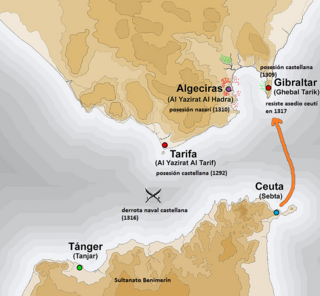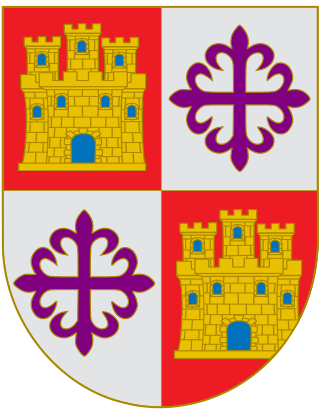
Peter, called Peterthe Cruel or the Just, was King of Castile and León from 1350 to 1369. Peter was the last ruler of the main branch of the House of Ivrea. He was excommunicated by Pope Urban V for his persecutions and cruelties committed against the clergy.

The Order of Calatrava was one of the four Spanish military orders and the first military order founded in Castile, but the second to receive papal approval. The papal bull confirming the Order of Calatrava was given by Pope Alexander III on September 26, 1164. Most of the political and military power of the order had dissipated by the end of the 15th century, but the last dissolution of the order's property did not occur until 1838.
This is a timeline of notable events during the period of Muslim presence in Iberia, starting with the Umayyad conquest in the 8th century.

The Order of Alcántara, also called the Knights of St. Julian, was originally a military order of León, founded in 1166 and confirmed by Pope Alexander III in 1177.
Nasr, full name Abu al-Juyush Nasr ibn Muhammad, was the fourth Nasrid ruler of the Emirate of Granada from 14 March 1309 until his abdication on 8 February 1314. He was the son of Muhammad II al-Faqih and Shams al-Duha. He ascended the throne after his brother Muhammad III was dethroned in a palace revolution. At the time of his accession, Granada faced a three-front war against Castile, Aragon and the Marinid Sultanate, triggered by his predecessor's foreign policy. He made peace with the Marinids in September 1309, ceding to them the African port of Ceuta, which had already been captured, as well as Algeciras and Ronda in Europe. Granada lost Gibraltar to a Castilian siege in September, but successfully defended Algeciras until it was given to the Marinids, who continued its defense until the siege was abandoned in January 1310. James II of Aragon sued for peace after Granadan defenders defeated the Aragonese siege of Almería in December 1309, withdrawing his forces and leaving the Emirate's territories by January. In the ensuing treaty, Nasr agreed to pay tributes and indemnities to Ferdinand IV of Castile and yield some border towns in exchange for seven years of peace.
Abu'l-Walid Ismail I ibn Faraj was the fifth Nasrid ruler of the Emirate of Granada on the Iberian Peninsula from 1314 to 1325. A grandson of Muhammad II on the side of his mother Fatima, he was the first of the lineage of sultans now known as the al-dawla al-isma'iliyya al-nasriyya. Historians characterise him as an effective ruler who improved the emirate's position with military victories during his reign.

The Emirate of Granada, also known as the Nasrid Kingdom of Granada, was an Islamic realm in the southern Iberian Peninsula during the Late Middle Ages. It was ruled by the Nasrids, a dynasty of Arab origin. It was the last independent Muslim state in Western Europe.

The Granada War was a series of military campaigns between 1482 and 1492 during the reign of the Catholic Monarchs, Isabella I of Castile and Ferdinand II of Aragon, against the Nasrid dynasty's Emirate of Granada. It ended with the defeat of Granada and its annexation by Castile, ending the last remnant of Islamic rule on the Iberian peninsula.
Abu al-Walid Ismail II ibn Yusuf was the ninth Nasrid ruler of the Emirate of Granada on the Iberian Peninsula. He reigned from 23 August 1359 until his death.
Abu Abdullah Muhammad VI ibn Ismail, also known by his Castilian nickname el Bermejo and the regnal names al-Ghālib bi 'llāh and al-Mutawakkil ʿalā 'llāh, was the tenth Sultan of the Emirate of Granada. A member of the Nasrid dynasty, he ruled for a brief period between June or July 1360 and April 1362.

The Battle of Linuesa was an action fought on 21 December 1361 in the city of Huesa, Kingdom of Jaén. The battle was fought between the Kingdom of Castile and the forces of the Emirate of Granada. The battle resulted in a victory for the forces of the Kingdom of Castile.

The first siege of Gibraltar was a battle of the Spanish Reconquista that took place in 1309. The battle pitted the forces of the Crown of Castile under the command of Juan Núñez II de Lara and Alonso Pérez de Guzmán, against the forces of the Emirate of Granada who were under the command of Sultan Muhammed III and his brother, Abu'l-Juyush Nasr.

The second siege of Gibraltar was an abortive attempt in 1316 by the forces of the Azafid Ceuta and the Nasrid Emirate of Granada to recapture Gibraltar, which had fallen to the forces of Ferdinand IV of Castile in 1309.
Abu Malik Abd al-Wahid was a son of the Marinid sultan of Morocco, Abu al-Hasan Ali ibn Othman. Although he had lost an eye, Malik was a capable military commander and served as governor of Algeciras and the Marinids' principal general in Al Andalus. He captured Gibraltar from Castile in June 1333 and participated in his father's campaign against rebels in the Kingdom of Tlemcen the following year. He was killed by Castilian forces in 1339 after being ambushed on the way back from a raid against the Castilian-held town of Jerez de la Frontera.

The siege of Algeciras (1369) was undertaken during the period of the Reconquest of Spain by Muhammad V, the Emir of Granada to reclaim the city of Al-Hadra Al-Yazirat, called Algeciras by the Christians, in the Kingdom of Castile. The siege lasted just three days, and the sultan was victorious. The Muslims thus regained a major city which had been in Castilian hands since Alfonso XI of Castile took it from the Moroccans after the long 1342–1344 siege. Ten years after the capture of the city, in 1379 the sultan of Granada decided to completely destroy the city to prevent it falling into Christian hands. It was impossible to defend the place at a time when the Muslim kings of the Iberian Peninsula had lost much of military power they enjoyed in earlier centuries.

The Battle of Los Alporchones was a battle of the Spanish Reconquista that took place on 17 March 1452. The battle was fought between the troops of the Emirate of Granada and the combined forces of the Kingdom of Castile and its client kingdom, the Kingdom of Murcia. The Moorish army was commanded by Malik ibn al-Abbas and the Castilian troops were commanded by Alonso Fajardo el Bravo, the head of the House of Fajardo and the Alcalde of Lorca Castle. The battle was fought in the area around the city of Lorca and resulted in a victory for the Kingdom of Castile.

Enrique Enríquez the Younger was a nobleman of Castile, son of Enrique Enríquez the Elder. He was lord of Villalba de los Barros, Nogales, Almendral, La Parra, Begíjar and other towns. He was Adelantado Mayor of the border of Andalusia, chief justice of the King's House, Chief of the forces of the bishopric and Kingdom of Jaén, Mayor of Seville and Knight of the Band.
Diego García de Padilla was a Spanish nobleman who became Master of the Order of Calatrava. His sister María de Padilla was the wife of King Peter of Castile, the Cruel. Padilla fought for Peter of Castile in the wars against Aragon and Granada. In the Castilian Civil War (1366–69) he went over to the side of Henry of Trastámara.
Juan Núñez de Prado, illegitimate son of Infanta Blanche of Portugal and a Portuguese nobleman named Pedro Nunes Carpinteyro, was a nobleman in the 14th century who became Master of the Order of Calatrava in 1325 after leading a revolt against the former Master. There was a prolonged dispute before his position was recognized. After he fell out of favor with King Peter of Castile he was removed from office and murdered.











